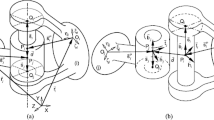Abstract
The development and computational implementation, on a multibody dynamics environment, of a constitutive relation to model bushing elements associated with mechanical joints used in the models of road and rail vehicles is presented here. These elements are used to eliminate vibrations in vehicles, due to road irregularities, to allow small misalignment of axes, to reduce noise from the transmission, or to decrease wear of the mechanical joints. Bushings are made of a special rubber, used generally in energy dissipation, which presents a nonlinear viscoelastic relationship between the forces and moments and their corresponding displacements and rotations. In the methodology proposed here a finite element model of the bushing is developed in the framework of the finite element code ABAQUS to obtain the constitutive relations of displacement/rotation versus force/moment for different loading cases. The bushing is modeled in a multibody code as a nonlinear restrain that relates the relative displacements between the bodies connected with the joint reaction forces, and it is represented by a matrix constitutive relation. The basic ingredients of the multibody model are the same vectors and points relations used to define kinematic constraints in any multibody formulation. One particular, and relevant, characteristic of the formulation now presented is its ability to represent standard kinematic joints, clearance, and bushing joints just by defining appropriate constitutive relations. Spherical, revolution, cylindrical, and translational bushing joints are modeled, implemented, and demonstrated through the simulation of two multibody models of a road vehicle, one with perfect kinematic joints for the suspension sub-systems, and other with bushing joints. The tests conducted include an obstacle avoidance maneuver and a vehicle riding over bumps. It is shown that the bushing models for vehicle multibody models proposed here are accurate and computationally efficient so that they can be included in the vehicle models leading reliable simulations.
Similar content being viewed by others
References
Shiib, T., Suda, Y.: Evaluation of driver’s behavior with multibody-based driving simulator. Multibody Syst. Dyn. 17(2–3), 195–208 (2007)
Mavros, G.: On the objective assessment and quantification of the transient-handling response of a vehicle. Vehicle Syst. Dyn. 45(2), 93–112 (2007)
Park, J., Nikravesh, P.: Effect of steering-housing rubber bushings on the handling responses of a vehicle. SAE International Congress & Exposition, Detroit, Michigan (1997)
Ahn, Y.-K., Kim, Y.-C., Yang, B.-S., Ahmadian, M., Ahn, K.-K., Morishita, S.: Optimal design of an engine mount using an enhanced genetic algorithm with simplex method. Vehicle Syst. Dyn. 43(1), 57–81 (2005)
Vahid, O., Khajepour, A., Ismail, F.: In situ body mount optimization: theory and experiment. Vehicle Syst. Dyn. 45(12), 1131–1147 (2007)
Kim, S.-S., Jeong, W.: Subsystem synthesis method with approximate function approach for a real-time multibody vehicle model. Multibody Syst. Dyn. 17(2–3), 141–156 (2007)
Polach, P., Hajžman, M.: Design of characteristics of air-pressure-controlled hydraulic shock absorbers in an intercity bus. Multibody Syst. Dyn. 19(1–2), 73–90 (2008)
Docquier, N., Fisette, P., Jeanmart, H.: Multiphysic modelling of railway vehicles equipped with pneumatic suspensions. Vehicle Syst. Dyn. 45(6), 505–524 (2007)
Kim, J.H., Yang, J., Abdel-Malek, K.: A novel formulation for determining joint constraint loads during optimal dynamic motion of redundant manipulators in DH representation. Multibody Syst. Dyn. 19(42), 427–451 (2008)
Kövecses, J., Angeles, J.: The stiffness matrix in elastically articulated rigid-body systems. Multibody Syst. Dyn. 18(2), 169–184 (2007)
Flores, P., Ambrósio, J., Pimenta Claro, J., Lankarani, H.: Kinematics and Dynamics of Multibody Systems with Imperfect Joints: Models and Case Studies. Springer, Dordrecht (2008)
Flores, P., Ambrósio, J., Claro, J., Lankarani, H., Koshy, C.: Lubricated revolute joints in rigid multibody systems. Nonlinear Dyn. (2008). doi:10.1007/s11071-008-9399-2
Erkaya, S., Uzmay, İ.: A neural-genetic (NN–GA) approach for optimizing mechanisms having joints with clearance. Multibody Syst. Dyn. 20(1), 69–84 (2008)
Nikravesh, P.: Computer-Aided Analysis of Mechanical Systems. Prentice-Hall, Englewood Cliffs (1988)
Kang, J., Yun, J., Lee, J., Tak, T.: Elastokinematic analysis and optimization of suspension compliance characteristics. Society of Automative Engineers (1997)
Kadlowec, J., Wineman, A., Hulbert, G.: Elastomer bushing response: Experiments and finite element modeling. Acta Mech. 163, 25–38 (2003)
Ledesma, R., Ma, Z., Hulbert, G., Wineman, A.: A nonlinear viscoelastic bushing element in multibody dynamics. Comput. Mech. 17, 287–296 (1996)
Shampine, L., Gordon, M.: Computer Solution of Ordinary Differential Equations: The Initial Value Problem. Freeman, San Francisco (1975)
Gear, C.W.: Numerical solution of differential-algebraic equations. IEEE Trans. Circuit Theory CT-18, 89–95 (1982)
Nikravesh, P.: Initial condition correction in multibody dynamics. Multibody Syst. Dyn. 18(1), 107–115 (2007)
Ambrósio, J., Neto, A.: Stabilization methods for the integration of DAE in the presence of redundant constraints. Multibody Syst. Dyn. 10, 81–105 (2003)
ABAQUS User’s Manual. Pawtucket, MA, Hibbitt, Karlsson & Sorensen (1999)
Murray, D.: Inside Solidworks. OnWord Press, Clifton Park (2005)
Gim, G., Nikravesh, P.E.: An analytical model of pneumatic tyres for vehicle dynamic simulations. Part 3: Validation against experimental data. Int. J. Vehicle Des. 12(2), 217–228 (1991)
Verissimo, P.: Improved bushing models for vehicle dynamics. M.S. Thesis, Instituto Superior Técnico, Technical University of Lisbon, Portugal (2007)
Author information
Authors and Affiliations
Corresponding author
Rights and permissions
About this article
Cite this article
Ambrósio, J., Verissimo, P. Improved bushing models for general multibody systems and vehicle dynamics. Multibody Syst Dyn 22, 341–365 (2009). https://doi.org/10.1007/s11044-009-9161-7
Received:
Accepted:
Published:
Issue Date:
DOI: https://doi.org/10.1007/s11044-009-9161-7




